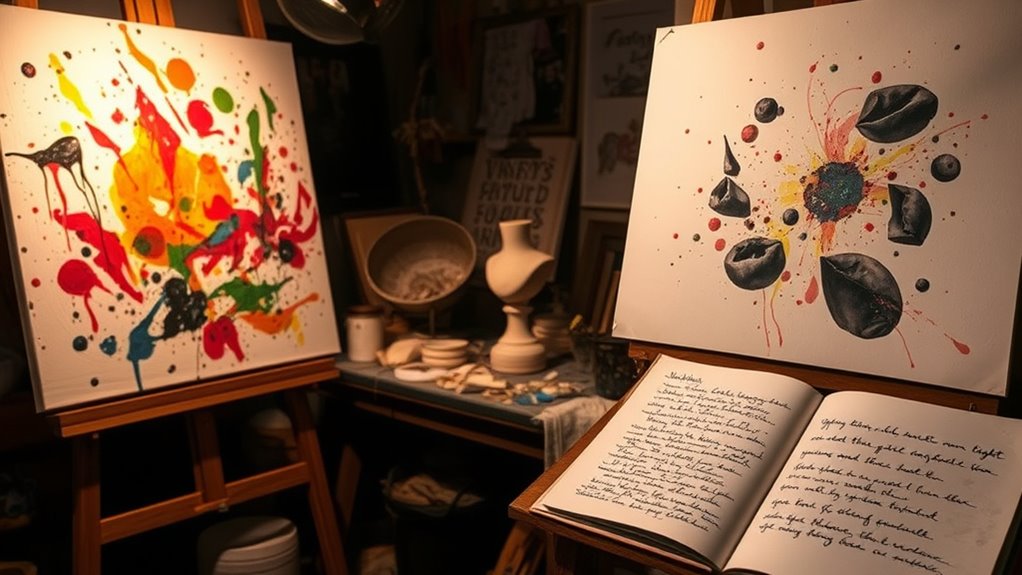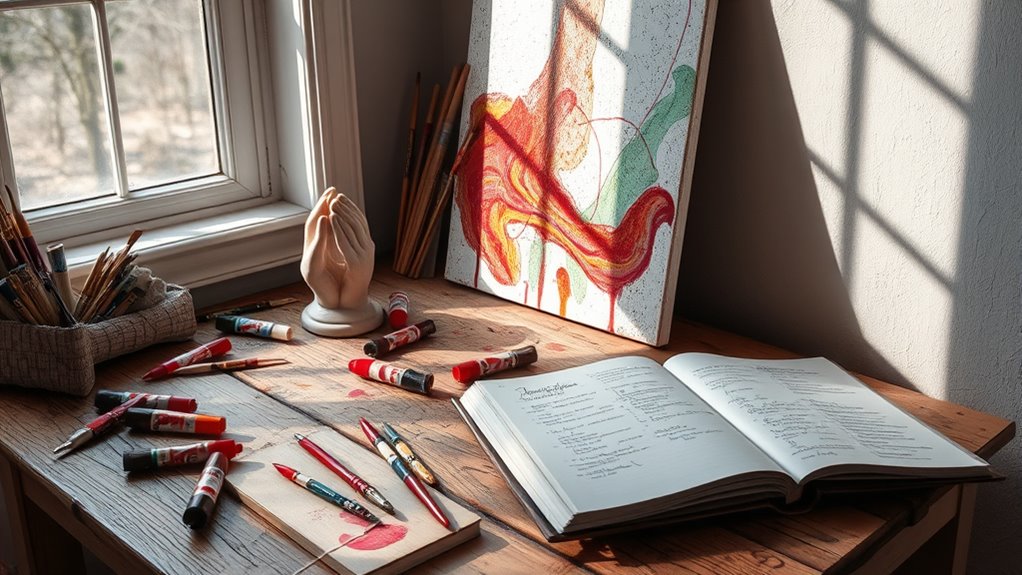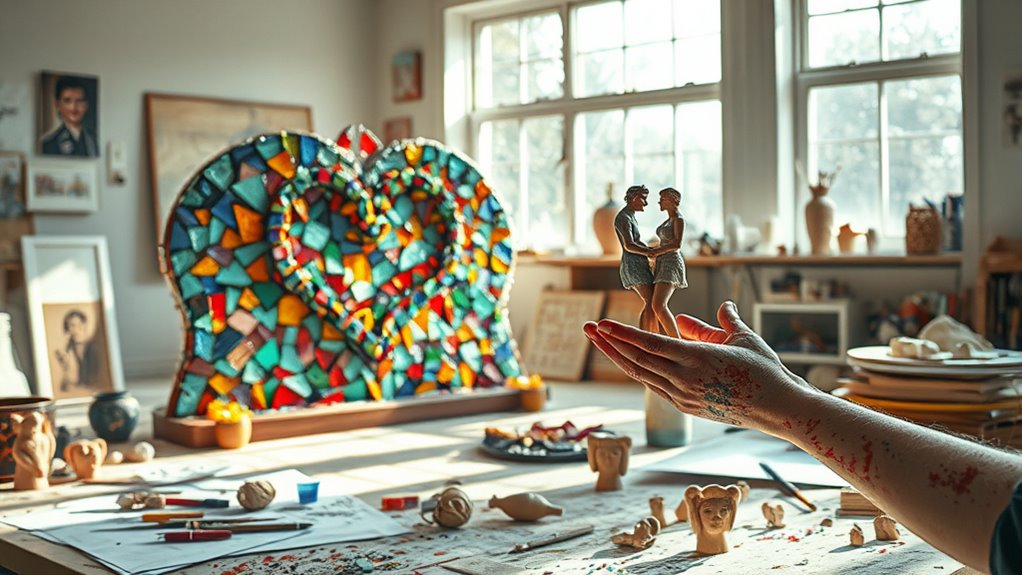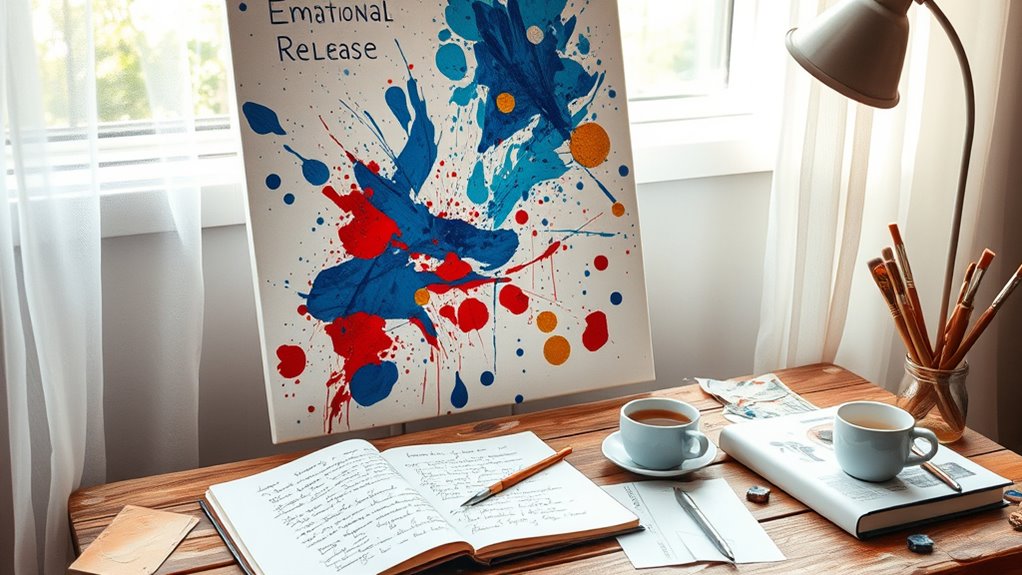Using art to process grief offers a powerful way to express and understand your emotions. Different mediums, like painting, mixed media, or digital art, allow you to personalize your healing. Engaging in creative activities helps reduce stress, foster connection, and preserve memories. Techniques like color therapy and visual journaling deepen emotional exploration. Practicing self-compassion and embracing imperfections can strengthen resilience. Keep exploring these approaches to learn more about transforming pain into healing through art.
Key Takeaways
- Art provides a therapeutic outlet for emotional expression and processing grief through symbolic imagery and color therapy.
- Engaging in creative activities like painting, journaling, or mixed media helps release tension and foster emotional clarity.
- Community art projects and shared workshops promote connection, support, and collective healing through collective expression.
- Supportive creative circles encourage vulnerability, self-compassion, and resilience, aiding individuals in navigating grief.
- Embracing imperfections in art fosters self-love and growth, transforming raw pain into meaningful, healing artistic expression.
The Role of Art in Processing Emotions

Art provides a powerful outlet for processing emotions, especially during times of grief. Through color therapy, you can tap into your feelings by selecting hues that resonate with your mood, helping you express what words can’t. Bright colors might symbolize hope, while darker shades can reflect sorrow or introspection. Symbolic imagery also plays an essential role; you might create or interpret images that represent your grief, such as a stormy sky or a blooming flower, helping you externalize and understand your emotions. Engaging in these visual expressions allows you to process complex feelings in a safe, personal way. Instead of suppressing pain, you channel it into meaningful art, fostering emotional clarity and healing during difficult times. Utilizing Symbolic imagery can deepen your emotional exploration, providing additional tools for healing through art.
Different Artistic Mediums for Grief Expression

Different artistic mediums offer diverse ways to express and process grief, allowing you to choose the form that resonates most deeply with your feelings. Digital painting provides a flexible, accessible option for creating vivid, emotive images that capture your inner landscape. It enables you to experiment with colors and textures without physical mess or limitations. Mixed media, on the other hand, combines various materials like paper, fabric, and found objects, giving you the freedom to craft layered, textured pieces that reflect complex emotions. These mediums allow you to channel grief into visual forms, offering a safe space for exploration and release. Additionally, exploring creative processes associated with various art forms can deepen your healing experience. By selecting the right medium, you can personalize your healing journey, transforming raw pain into meaningful, expressive art.
Therapeutic Benefits of Creative Activities

Engaging in creative activities can provide powerful therapeutic benefits, helping you process and release grief in a healthy way. These activities promote emotional release by allowing you to express feelings that might be hard to put into words. They also aid in stress reduction, calming your mind during difficult times. Creative pursuits like painting or writing give you a safe space to explore emotions without judgment. Understanding the importance of color accuracy and visual clarity can enhance your engagement with artistic expression, making the process even more impactful.
Personal Stories of Artistic Healing

Many people find that creating art helps them process grief in a deeply personal way. Through their artwork, you can preserve memories, capturing moments that hold special significance. This act of memory preservation allows you to hold onto the loved ones or experiences that shaped you, offering comfort and connection. At the same time, art provides a powerful outlet for emotional release, helping you express feelings that may be hard to put into words. Whether it’s painting, sculpting, or drawing, your creative process becomes a safe space to explore and process your grief. Engaging in art therapy techniques can further enhance this healing process by combining creative expression with psychological support. Sharing these personal stories can inspire others to find healing in their own artistic journeys, showing that grief can be transformed into a meaningful, cathartic experience.
Techniques to Use Art as a Healing Tool

Have you considered using specific techniques to turn your art into a more effective healing tool? Techniques like color therapy and visual journaling can deepen your emotional processing. Color therapy involves choosing colors that reflect or influence your mood, helping you access and regulate feelings. Visual journaling combines images, words, and symbols to explore your grief creatively. Here’s a quick overview:
| Technique | How It Helps | Tips |
|---|---|---|
| Color Therapy | Evokes emotions, promotes calm | Use colors that resonate |
| Visual Journaling | Externalizes feelings, reflection | Draw or collage daily |
| Expressive Drawing | Releases tension, self-awareness | Don’t worry about art skills |
| Guided Imagery | Visualizes healing, hope | Use prompts or prompts |
These methods offer accessible ways to process grief through art. Understanding the principles of art therapy can enhance your engagement with these techniques.
Incorporating Art Therapy Into Daily Life

Incorporating art therapy into your daily routine can create a consistent outlet for expressing emotions and processing grief. You might start with mindful journaling, taking time each day to write honestly about your feelings. Try to focus fully on your thoughts without judgment. Incorporate expressive dance into your schedule, allowing your body to move freely and release pent-up emotions. To deepen your practice, consider these steps:
Daily art practices like journaling and dance help express emotions and foster healing.
- Dedicate a specific time each day for creative expression.
- Use art as a way to explore complex emotions.
- Combine movement with reflection to foster healing.
- Embrace the process without worrying about perfection.
- Engage in creative processes such as drawing, painting, or sculpting to further facilitate emotional release and healing.
The Science Behind Creativity and Emotional Recovery

Engaging in creative activities isn’t just about self-expression; scientific research shows it can substantially aid emotional recovery. Neuroscience insights reveal that art stimulates neural pathways involved in emotional regulation, helping you process grief more effectively. When you create, your brain releases neurotransmitters like dopamine, which boost mood and reduce stress. This process rewires neural circuits, fostering resilience. Consider how different art forms influence your emotions:
| Art Activity | Effect on Emotional Regulation |
|---|---|
| Painting or Drawing | Facilitates expression of complex feelings |
| Music Composition | Releases endorphins, easing pain |
| Writing or Poetry | Helps organize thoughts, reduce anxiety |
Creating Memorials Through Art

Creating memorials through art offers a powerful way to honor loved ones and process grief. Memorial art, like grief sculpture, transforms pain into lasting symbols of remembrance. When creating a memorial, consider these elements:
- Personal Significance: Incorporate symbols or objects that represent your loved one’s life.
- Material Choice: Use materials that evoke emotion, such as stone or metal, for durability and depth.
- Location: Select a meaningful space that encourages reflection and connection.
- Intent: Focus on expressing your unique grief journey, making the piece a personalized tribute.
Through these steps, your memorial art becomes more than just a tribute—it’s a healing act that captures memories and emotions, fostering ongoing connection and comfort. Additionally, exploring different art forms can deepen the emotional impact of the memorial, helping you express grief creatively and find solace through visual storytelling.
Finding Support and Community Through Artistic Expression

Joining shared artistic spaces can connect you with others who understand your grief. Participating in collaborative healing projects allows you to express emotions and find comfort together. Supportive creative circles give you a safe environment to share, listen, and grow through art. Incorporating creative expression into your healing process can also help you develop new skills and coping mechanisms.
Shared Artistic Spaces
Shared artistic spaces offer a powerful way to find support and build community when you’re grieving. These spaces create a sense of belonging and shared purpose, making healing less solitary. Participating in community murals allows you to visually express your emotions alongside others, fostering connection. Shared workshops provide a safe environment to explore your feelings, gain new skills, and receive feedback. By engaging in these activities, you recognize that you’re not alone in your journey. Additionally, engaging in public events like art exhibitions or performances can amplify your voice and help you connect with a broader community of like-minded individuals.
Collaborative Healing Projects
Collaborative healing projects bring people together through collective artistic efforts that foster both support and a sense of community. Engaging in collaborative art allows you to share your grief while connecting with others who understand your experience. Community murals, in particular, provide a powerful platform for collective expression, transforming shared pain into visual stories of resilience and hope. As you work alongside others, you’ll find strength in the unity of purpose, breaking isolation and building bonds through creative collaboration. These projects not only serve as outlets for individual grief but also create lasting symbols of collective healing. Incorporating meaningful symbols into artwork can deepen the emotional impact and reinforce shared values during the healing process. By contributing to community murals and collaborative art initiatives, you actively participate in a healing process that emphasizes connection, empathy, and shared resilience.
Supportive Creative Circles
Supportive creative circles offer a safe space where you can openly express your feelings and find comfort through art. These groups foster emotional support, reminding you you’re not alone in your grief. Within these circles, your artistic expression becomes a shared journey, strengthening connections and healing. To deepen your experience, consider these aspects:
- Trust is built through confidentiality and shared vulnerability.
- Diverse perspectives enrich your understanding of grief.
- Regular participation nurtures emotional resilience.
- Celebrating progress boosts confidence and hope.
- Incorporating artistic techniques like collage or mixed media can enhance emotional expression and facilitate healing.
Joining supportive creative circles helps you channel grief constructively, providing community and empathy. Engaging with others through artistic expression creates a powerful foundation for healing, reminding you that your feelings are valid and shared. This collective approach can transform grief into an empowering, creative process.
Encouraging Self-Compassion Through Creative Practice

When you create without judgment, you learn to accept imperfections as part of your healing process. Practice gentle self-talk to nurture kindness toward yourself, even when your art isn’t perfect. Embracing these habits helps you develop self-compassion and find comfort in your creative journey. Being mindful of your hours today can help you plan your art sessions during times when you feel most supported.
Embrace Imperfections Freely
Embracing imperfections in your creative practice allows you to cultivate self-compassion and reduce the fear of making mistakes. When you engage in mindful doodling or abstract improvisation, you learn to accept spontaneity and flaws as part of the process. Remember these lessons:
- Every mark, even if imperfect, contributes to your unique expression.
- Mistakes become opportunities for discovery rather than failures.
- Embracing flaws fosters resilience and patience.
- Authenticity emerges when you let go of perfectionism.
- Recognizing the importance of self-acceptance can enhance your creative growth and overall well-being.
Practice Gentle Self-Talk
Practicing gentle self-talk during your creative process can substantially boost your self-compassion and ease feelings of self-criticism. Use mindful affirmations to remind yourself that healing takes time and that your efforts are valid. Incorporate compassionate language, speaking to yourself as you would to a dear friend, acknowledging your pain without judgment. When doubts arise, gently counter them with kind phrases like “You’re doing your best” or “It’s okay to feel this way.” This practice reinforces a nurturing mindset that supports your emotional well-being. As you create, focus on nurturing yourself with words rooted in understanding and patience. Developing a growth mindset can help you view setbacks as opportunities for learning and resilience. Over time, these mindful affirmations and compassionate expressions become a natural part of your creative journey, fostering resilience and self-love.
Frequently Asked Questions
How Can Art Help in Confronting Difficult Memories?
Art helps you confront difficult memories by allowing you to use visual storytelling to express complex emotions. When you create, you engage in emotional release, transforming painful experiences into visual forms. This process provides a safe space to explore and understand your feelings, making it easier to process grief. Through art, you gain clarity and catharsis, turning difficult memories into a meaningful part of your healing journey.
What Are Common Emotional Barriers When Creating Art About Grief?
Imagine your emotions are a locked door; emotional resistance and vulnerability barriers can keep you from opening it. You might fear judgment, shame, or feeling overwhelmed, which blocks your creative flow. These barriers often stem from a fear of exposing your innermost feelings. To move past them, remind yourself that art is a safe space. Embrace imperfection, and trust that vulnerability can be a powerful step toward healing through your creative process.
Can Children Benefit From Artistic Approaches to Cope With Loss?
Yes, children can benefit from artistic expression to cope with loss. You help foster childhood resilience by encouraging them to express their feelings creatively. Artistic activities give children a safe outlet to process grief, reduce emotional barriers, and build understanding. When you support their creative process, you enable healing and strengthen their ability to navigate complex emotions, ultimately promoting emotional well-being during difficult times.
How Do Cultural Differences Influence Grief-Themed Artistic Expression?
Did you know that over 80% of cultures incorporate specific artistic traditions to process grief? Cultural differences shape how you express sorrow through art by emphasizing unique symbols and rituals. Cultural symbols often reflect shared beliefs, guiding your artistic expression. These symbols help you connect with community and tradition, making grief more manageable. Recognizing these influences can deepen your understanding of how diverse artistic approaches serve as healing tools across cultures.
What Signs Indicate Art Therapy Is Effective for Grief Processing?
You’ll notice art therapy is effective for grief processing when you experience increased emotional awareness and find relief through creative expression. If you feel more in touch with your feelings, notice a reduction in emotional intensity, or gain new insights, these are signs it’s working. Additionally, if creating art helps you process complex emotions or provides comfort, you’re likely benefiting from the therapeutic process.
Conclusion
Embrace the empowering ease of expression, allowing art to act as your honest healer. Through colorful creations and heartfelt gestures, you’ll find freedom from grief’s grip. Let your personal process paint a powerful path toward peace, pushing past pain and into a place of purpose. Remember, this creative journey isn’t just about healing—it’s about harnessing hope, healing hurt, and holding onto hope. Your artistic avenue awaits—step in and start healing today.









